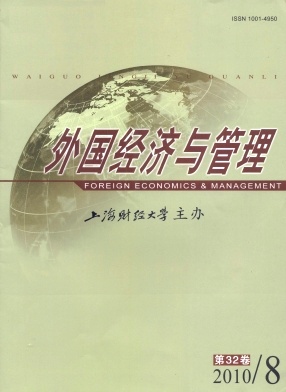试论价值创造的本原性质、内在机理与治理要义——基于利益相关者治理视角
外国经济与管理 2010 年 第 32 卷第 08 期, 页码:10 - 17
摘要
参考文献
摘要
本文针对理论上对价值创造相关问题仍存在分歧的现实,基于利益相关者治理视角对价值创造进行了解构。本文认为,价值创造的本原性质是以有效履约为目标的"创造知识"与"知识创造"的过程,也是以价值创造网络为平台利益相关者之间进行互补性"创出"的结果;其逻辑起点是利益相关者的合作剩余及分配;价值创造的治理要义在于资本承诺、组织整合与内部人控制,关键利益相关者治理观更能促进价值创造的实现。
[1]Modigliani,Franco,and Miller,Merton H.The cost of capital,corporationfinance,and the theory of invest ment:Reply[J].A-merican Economic Review,1959,49(4):655-669.
[2]Copeland,Tom,Koller,Ti m,and Jack Murrin.Valuation:Measuring and managing the value of companies[M].(2nd Ed.).New York:Wiley,1994.
[3]Firer,Steven,and Williams,S Mitchell.Intellectual capital andtraditional measures of corporate performance[J].Journal of In-tellectual Capital,2003,4(3):5-6.
[4]Porter,Michael E.Competitive advantage[M].New York,NY:The Free Press,1985.
[5]Rayport,Jeffrey F,and Sviokla,John J.Exploiting the virtual value chain[J].Harvard Business Review,1995,73(6):75-85.
[6]Kothandaraman,Prabhakar,and Wilson,David T.The future of competition[J].Industrial Marketing Management,2001,30(4):379-389.
[7]Bontis,B,Keow,WC,and Richardson,S.Intellectual capital and business performancein Malaysianindustries[J].Journal ofIntellectual Capital,2000,1(1):85-100.
[8]Sullivan,Patrick H.Value-driven intellectual capital:Howto convert intangible corporate assets into market value[M].NewYork:John Wiley&Sons,2000.
[9]Barney,Jay.Firm.resources and sustained competitive advantage[J].Journal of Management,1991,17(1):107-110.
[10]Collis,David J,and Montgomery,Cynthia A.Corporate strategy:Aresource-based approach[M].Boston:Irwin,McGraw-Hill,1998.
[11]Penrose,Edith T.The theory of the growth of the firm[M].New York:John Wiley&Sons,1959.
[12]Langlois,Richard N,and Robertson,Paul L.Firms,markets and economic change:A dynamic theory of business institutions[M].London:Routledge,1995.
[13]Eisenhardt,Kathleen M,and Martin,Jeffrey A.Dynamic capabilities:What are they?[J].Strategic Management Journal,2000,21(10-11):1 105-1 121.
[14]Dosi,Giovanni,Teece,David,and Chytry,Josef.Understandingindustrial and corporate change[M].Oxford:Oxford Uni-versity Press,2005.
[15]O’Sullivan,Mary A.Contests for corporate control:Corporate governance and economic performance in the United States andGermany[M].New York:Oxford University Press,2000.
[16]Cable,John R,and FitzRoy,Felix R.Productive efficiency,incentives and employee participation:Some preli minary results forWest Germany[J].Kyklos,1980,33(1):100-121.
[17]Wilson,Nicholas,Cable,John R,and Peel,Michael J.Quit rates and the i mpact of participation,profit-sharing and unioniza-tion:Empirical evidence form UKengineering firms[J].British Journal of Industrial Relations,1990,28(2):197-213.
[18]Blair,Margaret.Wealth creation and wealth sharing:Acolloquiumon corporate governance and invest ments in human capital[M].Washington D C:Brookings Institute,1996.
[19]Freeman,Edward R,and Evan,William M.Corporate governance:Astakeholder interpretation[J].Journal of Behavioral E-conomics,1990,19(4):337-359.
[20]Rajan,Raghuram G,and Zingales,Luigi.Power in a theory of the firm[J].Quarterly Journal of Economics,1998,113(2):387-432.
[2]Copeland,Tom,Koller,Ti m,and Jack Murrin.Valuation:Measuring and managing the value of companies[M].(2nd Ed.).New York:Wiley,1994.
[3]Firer,Steven,and Williams,S Mitchell.Intellectual capital andtraditional measures of corporate performance[J].Journal of In-tellectual Capital,2003,4(3):5-6.
[4]Porter,Michael E.Competitive advantage[M].New York,NY:The Free Press,1985.
[5]Rayport,Jeffrey F,and Sviokla,John J.Exploiting the virtual value chain[J].Harvard Business Review,1995,73(6):75-85.
[6]Kothandaraman,Prabhakar,and Wilson,David T.The future of competition[J].Industrial Marketing Management,2001,30(4):379-389.
[7]Bontis,B,Keow,WC,and Richardson,S.Intellectual capital and business performancein Malaysianindustries[J].Journal ofIntellectual Capital,2000,1(1):85-100.
[8]Sullivan,Patrick H.Value-driven intellectual capital:Howto convert intangible corporate assets into market value[M].NewYork:John Wiley&Sons,2000.
[9]Barney,Jay.Firm.resources and sustained competitive advantage[J].Journal of Management,1991,17(1):107-110.
[10]Collis,David J,and Montgomery,Cynthia A.Corporate strategy:Aresource-based approach[M].Boston:Irwin,McGraw-Hill,1998.
[11]Penrose,Edith T.The theory of the growth of the firm[M].New York:John Wiley&Sons,1959.
[12]Langlois,Richard N,and Robertson,Paul L.Firms,markets and economic change:A dynamic theory of business institutions[M].London:Routledge,1995.
[13]Eisenhardt,Kathleen M,and Martin,Jeffrey A.Dynamic capabilities:What are they?[J].Strategic Management Journal,2000,21(10-11):1 105-1 121.
[14]Dosi,Giovanni,Teece,David,and Chytry,Josef.Understandingindustrial and corporate change[M].Oxford:Oxford Uni-versity Press,2005.
[15]O’Sullivan,Mary A.Contests for corporate control:Corporate governance and economic performance in the United States andGermany[M].New York:Oxford University Press,2000.
[16]Cable,John R,and FitzRoy,Felix R.Productive efficiency,incentives and employee participation:Some preli minary results forWest Germany[J].Kyklos,1980,33(1):100-121.
[17]Wilson,Nicholas,Cable,John R,and Peel,Michael J.Quit rates and the i mpact of participation,profit-sharing and unioniza-tion:Empirical evidence form UKengineering firms[J].British Journal of Industrial Relations,1990,28(2):197-213.
[18]Blair,Margaret.Wealth creation and wealth sharing:Acolloquiumon corporate governance and invest ments in human capital[M].Washington D C:Brookings Institute,1996.
[19]Freeman,Edward R,and Evan,William M.Corporate governance:Astakeholder interpretation[J].Journal of Behavioral E-conomics,1990,19(4):337-359.
[20]Rajan,Raghuram G,and Zingales,Luigi.Power in a theory of the firm[J].Quarterly Journal of Economics,1998,113(2):387-432.
引用本文
王世权. 试论价值创造的本原性质、内在机理与治理要义——基于利益相关者治理视角[J]. 外国经济与管理, 2010, 32(8): 10–17.
导出参考文献,格式为:
上一篇:战略创业研究演进与前沿探析
下一篇:基于商业决策视角的伦理观研究述评





 6060
6060  884
884

